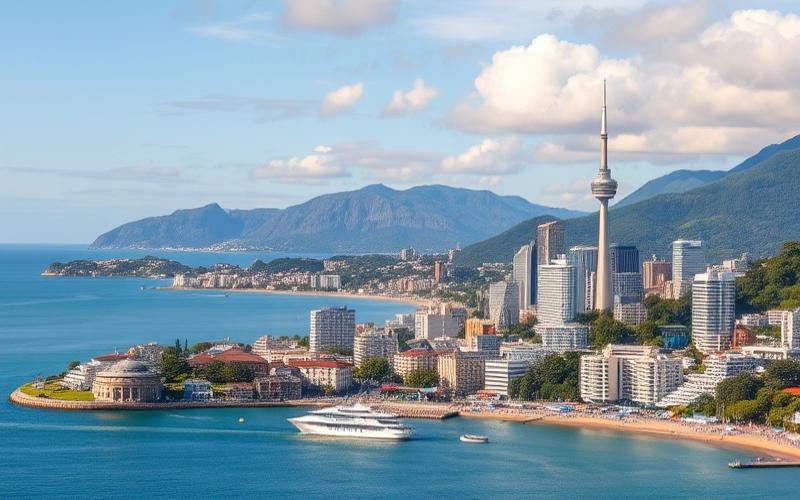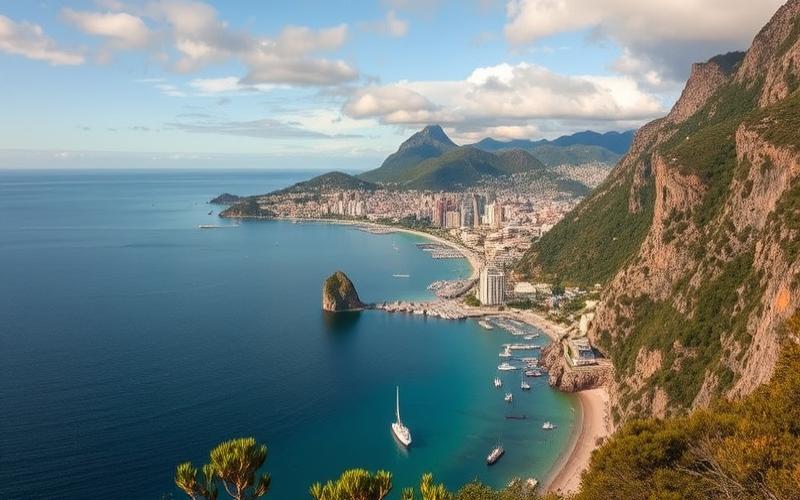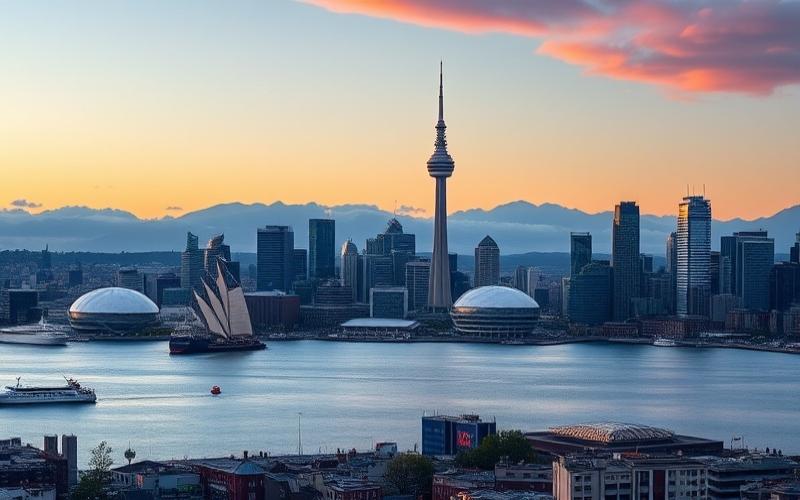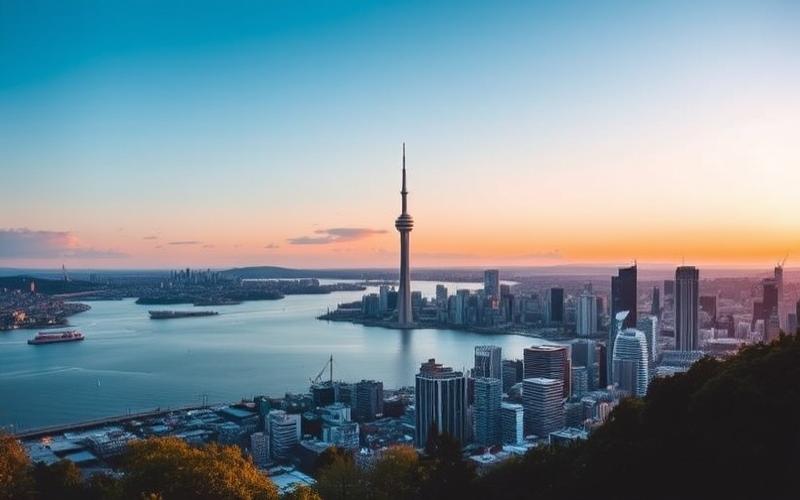
 Published on and written by Cyril Jarnias
Published on and written by Cyril Jarnias
New Zealand: A Leader in Sustainable Real Estate Development
At a time when the world is increasingly aware of the effects of global warming, New Zealand is positioning itself as a leader in sustainable development within the real estate sector.
Rigorous Environmental Standards for 2025
With 2025 approaching, the country is intensifying efforts to implement rigorous new environmental standards and incentive grants designed to promote green real estate.
The Benefits of a Sustainable Approach
These measures aim not only to reduce carbon footprint but also to stimulate innovation in building materials and sustainable technologies.
Good to Know:
By adopting these forward-thinking policies, New Zealand preserves its iconic natural landscapes while fostering green economic growth.
A Model for the Real Estate Industry
This approach could serve as a model for other nations. Let’s explore how these recent initiatives are transforming the real estate industry and what benefits they offer developers, buyers, and the environment.
Introduction to Green Building Standards in New Zealand
Green building standards encompass a set of rules, standards, and practices aimed at reducing the ecological footprint of the real estate sector while improving occupants’ quality of life. Their importance is part of a comprehensive sustainable development approach, where buildings become a key lever to limit greenhouse gas emissions, optimize energy consumption, and promote the preservation of natural resources.
Regulatory Framework in New Zealand
| Law/Standard | Main Objective | Recent Key Points |
|---|---|---|
| Building Act | General regulatory framework to ensure building safety, quality, and accessibility | Enhanced standards on energy efficiency and fire safety |
| Resource Management Act (RMA) | Sustainable land resource management and environmental control | Increased integration of ecological requirements in permit approvals |
| Healthy Homes Standards | Improvement of thermal comfort, insulation, ventilation, and moisture management for rental housing | Full compliance required by July 1, 2024 |
Historical evolution shows a progressive increase in requirements: initially focused on structural or sanitary building safety (Building Act), standards incorporated a strong environmental dimension starting in the early 2000s with the RMA. The “Healthy Homes Standards” system, gradually implemented since 2019 and fully enforced in 2024, illustrates this shift toward healthier housing: enhanced insulation, mandatory ventilation in damp rooms, and effective moisture control systems.
Main Objectives
- Reduce energy consumption
- Promote the use of sustainable materials
- Limit negative impacts on local biodiversity
- Provide a healthy environment for occupants
These objectives align with New Zealand’s national policies aiming for carbon neutrality by 2050, as well as the government strategy to improve public health through better-performing housing.
Expected Benefits
Environmental
- Significant reduction in CO₂ emissions related to heating/cooling
- Enhanced preservation of natural heritage (sustainable land/water management)
Economic
- Higher property valuation for assets meeting new requirements
- Long-term reduction in energy bills
Social
- Clear improvement in resident well-being/quality of life (less damp/cold housing)
- Reduction in respiratory illnesses associated with substandard housing
Concrete Examples
The City Rail Link program in Auckland not only incorporates low-carbon urban mobility but also includes numerous new buildings certified as “green” according to local standards. Many recent residential neighborhoods around Auckland-Wellington already benefit from modern infrastructure meeting these new requirements – high-performance thermal insulation and innovative collective systems for water/energy management.
New Measures Planned or Expected Revisions for 2025
The government plans further strengthening of minimum energy efficiency requirements during major renovations and possible expansion of the “Green Star NZ” label to existing buildings. A national consultation is also announced to integrate more requirements related to climate resilience in response to increasing extreme weather events.
Key Takeaway: New Zealand’s green real estate now relies on a robust legislative framework that continues to evolve dynamically, ensuring that every real estate project concretely contributes to building a low-carbon and resilient society.
Good to Know:
Green building standards in New Zealand play a crucial role in sustainable development, influencing how buildings are designed, constructed, and managed to minimize their environmental impact. These regulations, which include certifications like Green Star and Homestar, aim to reduce carbon footprint and improve energy efficiency. Since their initial implementation, these standards have evolved to better align with national policies, particularly regarding greenhouse gas emission reductions. Applying these standards brings significant benefits: energy savings, better indoor air quality, and increased property values. The Coastlands Aquatic Centre in Paraparaumu is a notable example, with its Green Star certification for sustainability. In 2025, revisions are expected to integrate more innovative technologies and strengthen energy performance requirements, reflecting an ongoing commitment to a greener future.
Green Certifications for a Sustainable Future
Overview of Main Environmental Certifications Applicable to Buildings in New Zealand
| Certification | Organization/Origin | Building Types Covered | Main Objectives |
|---|---|---|---|
| LEED | US Green Building Council | All types (offices, residential, etc.) | Energy performance, water/material management, innovation |
| Green Star NZ | New Zealand Green Building Council (NZGBC) | Commercial and public buildings | Overall sustainability: energy, water, materials, transport |
| Homestar | NZGBC | Residential (single-family homes/apartments) | Environmental performance of housing |
How These Certifications Encourage Sustainable Construction
- Incentives to reduce carbon footprint through energy efficiency and renewable energy use.
- Promotion of rational use of natural resources (water, recycled or local materials).
- Promotion of healthy indoor environments: improved indoor air quality and enhanced thermal comfort.
- Systematic integration of green technological innovations like smart energy management systems or rainwater harvesting.
Evaluated Criteria and Energy Performance by Certification
LEED
- Energy & Atmosphere: overall building energy efficiency
- Water: consumption/waste reduction
- Materials & Resources: responsible selection/recycling
- Indoor Environmental Quality
- Design Innovation
Green Star NZ
Evaluates 9 main categories:
- Energy/water/material management
- Sustainable transport
- Carbon emissions/waste management
- Land use & local ecology
- Health/well-being & innovation
Homestar
Residential-focused:
- Insulation/thermal performance
- Efficiency of electrical appliances/domestic hot water
- Potable water/stormwater/greywater management
- Use of non-toxic materials/responsible sourcing
Role in Promoting Green Innovations and Technology Adoption
Certifications require or reward innovative approaches:
- Installation of solar panels/geothermal heat pumps/smart systems to optimize consumption.
- Encouragement to adopt green roofs/rainwater harvesting.
Public recognition associated with these labels encourages developers/designers to exceed minimum regulatory requirements.
Alignment with Government Grants Planned for 2025
In response to national low-carbon objectives set by the New Zealand government to accelerate ecological transition:
List of expected synergies:
- Grants targeting LEED/Green Star/Homestar certified projects to fund energy-efficient technologies.
- Financial bonuses/simplified procedures for constructions achieving high levels in these certifications.
This promotes rapid scaling of sustainable practices compatible with national sustainable development ambitions.
Expected Long-Term Benefits
Significant reduction in energy costs through better insulation/technical performance.
Measurable improvement in indoor comfort and thus quality of life.
Increased property valuation for certified real estate portfolio.
Direct contribution to national climate commitments through reduced sectoral CO₂ emissions.
Widespread adoption of these frameworks thus raises overall standards while stimulating local innovation and sustainable real estate attractiveness.
Good to Know:
In New Zealand, green certifications such as LEED, Green Star NZ, and Homestar play a crucial role in promoting green real estate. LEED, for example, assesses energy performance and material selection, thereby encouraging the adoption of green technologies. Green Star NZ focuses on resource efficiency and design innovation, while Homestar sets criteria for thermal comfort and indoor air quality. These certifications align their criteria with government grants planned for 2025, thus supporting projects aimed at reducing the national carbon footprint. By encouraging sustainable construction, these certifications facilitate the achievement of the country’s sustainable development goals, while offering long-term energy cost reductions and improving the quality of life for New Zealand residents, demonstrating the viability of green buildings for a sustainable future.
Government Grants and Subsidies for Renewable Energy
The New Zealand government plans to continue and expand several major grant and subsidy programs for renewable energy starting in 2025, as part of its active policy to encourage green real estate.
Main Public Programs Planned or Maintained:
- Green Investment Fund endowed with 400 million NZD, aimed at supporting innovative projects to accelerate energy transition, particularly in the real estate sector.
- National Center for New Energy Development with a dedicated budget of 27 million NZD to stimulate research and integration of renewable technologies.
- Investments through the Provincial Growth Fund (3 billion NZD), with a significant portion funding sustainable energy infrastructure related to new real estate projects or renovation of existing buildings.
Prioritized Renewable Energies:
| Type | Priority | Current and Potential Deployment |
|---|---|---|
| Wind | Very High | 17 onshore farms (690 MW installed); offshore wind studies underway. |
| Solar | High | Currently small share (0.5%), strong potential for new/renovated buildings. |
| Geothermal | Medium | Approximately 20% of electricity mix already covered. |
| Hydroelectric | Historic/Priority | Nearly 60% of national mix; rarely used in new construction. |
Connection with Green Building Standards:
- Grants are conditional on meeting or exceeding New Zealand “Green Star” standards, which require superior energy performance, mandatory integration of a minimum share of on-site renewable energy production (solar PV panels or micro-wind turbines), and optimized carbon cycle management.
- Some programs offer additional financial bonuses if the real estate project achieves a higher green certification (“Green Star – Excellence”).
Concrete Examples:
Typical Grants by Real Estate Project Type
| Project Type | Possible Indicative Amount (Direct Grant) |
|---|---|
| Individual residential solar installation | Up to 7,500 NZD per new green-certified home |
| Collective residential development (>10 units) | Up to 15,000 NZD/unit depending on Green Star level |
| New commercial building | Grant up to 100,000 NZD + preferential financing |
Eligible Projects
- New construction labeled “Green Star”
- Major renovation achieving +50% energy efficiency
- Large-scale rooftop PV installation (>10 kWp)
Expected Impact on New Zealand Real Estate Market:
Grants are expected to:
- Significantly reduce initial costs of green real estate projects
- Accelerate standardization of high environmental certifications in all new residential or commercial programs
- Attract more institutional investors to this sector through improved profitability and increased valuation of labeled properties
Furthermore, these measures explicitly aim to rapidly increase the actual share of solar and further strengthen the already significant share of wind in all new urban developments from their design phase.
The official goal remains that all new urban construction be carbon neutral upon delivery thanks to targeted public grants – making massive integration of local renewable energy sources essential from the project phase.
This dynamic is expected to be a powerful lever for sustainably transforming both supply and demand across the entire real estate segment in New Zealand.
Good to Know:
Starting in 2025, New Zealand plans to maintain and expand several renewable energy grant programs as part of its policy to encourage green real estate. The New Zealand government particularly emphasizes solar and wind power, with grants covering up to 30% of installation costs for residential and commercial projects. Green building standards will also include energy performance requirements, encouraging developers to integrate renewable technologies into new constructions. For example, a residential construction project incorporating solar installations and energy recovery systems could receive a grant of up to 15,000 NZD. These incentives aim to reduce green construction costs, stimulate investments, and reduce the carbon footprint of the real estate market. Experts anticipate that these measures will increase the value of eco-friendly properties, encouraging a faster transition to a sustainable real estate portfolio in New Zealand.
Disclaimer: The information provided on this website is for informational purposes only and does not constitute financial, legal, or professional advice. We encourage you to consult qualified experts before making any investment, real estate, or expatriation decisions. Although we strive to maintain up-to-date and accurate information, we do not guarantee the completeness, accuracy, or timeliness of the proposed content. As investment and expatriation involve risks, we disclaim any liability for potential losses or damages arising from the use of this site. Your use of this site confirms your acceptance of these terms and your understanding of the associated risks.














































